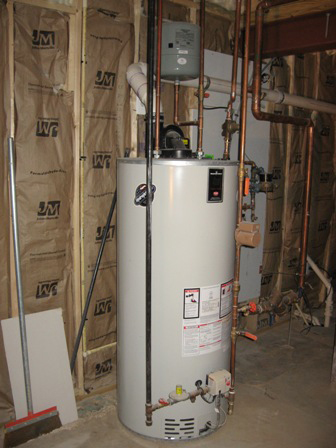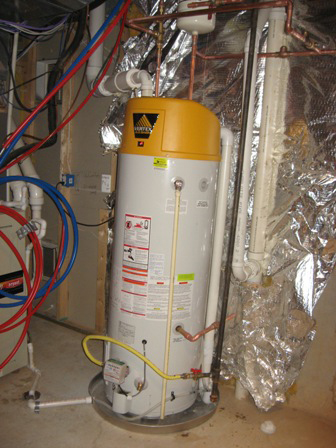Three types of gas tank hot water heaters for your renovation
Gas tanks are the most common hot water heaters in American homes. Here are three types to consider for your remodeling project.
The old standard: atmospherically vented tank
 The gas hot water heaters of our childhoods had the virtues of simplicity, reliability, and low initial cost. If your current hot water heater is a big tank with a metal flue attached to the top, yours is of this style. They do have one very nice feature: they will still work when the power is out. And, if you already have an existing flue (in good condition), they are inexpensive to install. But, there are some downsides to the old standard.
The gas hot water heaters of our childhoods had the virtues of simplicity, reliability, and low initial cost. If your current hot water heater is a big tank with a metal flue attached to the top, yours is of this style. They do have one very nice feature: they will still work when the power is out. And, if you already have an existing flue (in good condition), they are inexpensive to install. But, there are some downsides to the old standard.
First is the expense of the wasted fuel. Traditional tanks allow 20% or more of the fuel’s heat to waft away up the chimney. More is lost as the hot water cools from air moving through the flue in the middle of the tank. All in all, less than 60% of the fuel’s heat typically ends up as hot water.
Second, and perhaps more important, is the possible safety issue of backdrafting flue gasses. As with older, atmospherically vented furnaces (see Three Kinds of Gas Furnaces for your Remodeling Project), the only force that lifts the burned gas exhaust up the flue is the buoyancy of leftover heat in the gasses. This force is not that strong, and if anything goes wrong, the combustion byproducts can accidentally enter the home instead of going up the flue.
These combustion gasses are never safe, and can even be deadly if significant carbon monoxide is present. (A carbon monoxide detector is recommended by the Building Performance Institute for any home with gas-burning appliances.)
“Power Vent” tanks: the new standard
In our work as design build remodeling contractors, most of the heaters we have installed lately are tanks that overcome the problems with those old-fashioned, atmospherically-vented heaters.
 The simplest upgrade is a “power vented” tank. These have a fan that pulls the combustion gas out of the tank and pushes it through a plastic vent pipe to the outdoors. The fan setup reliably removes the flue gasses from the house, preventing the possible health and safety problems with natural draft heaters.
The simplest upgrade is a “power vented” tank. These have a fan that pulls the combustion gas out of the tank and pushes it through a plastic vent pipe to the outdoors. The fan setup reliably removes the flue gasses from the house, preventing the possible health and safety problems with natural draft heaters.
In the older heaters, a lot of heat has to be left in the flue gas so it will rise up the chimney. With the fan pushing the flue gas, more efficiency is possible because more of the heat can be left in the water instead.
“Sealed combustion” heaters are similar, with the same fan and flue gas pipe, but they additionally include an inlet pipe that brings outdoor air into the combustion chamber. That saves your conditioned air from being removed to the outside.
While power-vented tanks themselves cost more than an atmospheric-vented unit, the installed cost in a new construction situation is often lower. The plastic flue can run out a sidewall, and is inexpensive compared to the vertical metal flue (and framed-out chase through all floors above) that are needed for an atmospheric-vented heater.
Super-efficient “condensing” tanks
A couple of relatively new types of heaters take this sealed combustion concept further, with super-efficient heat exchangers that take even more of the heat out of the flue gasses, saving more on fuel costs. I’d separate these into two categories: stainless steel tanks with efficient exchangers, and a conventional steel version.
The stainless versions have been around a while. Polaris and Phoenix are the two brand names I’m aware of. For the true long-term thinker, these are possibly the lowest long-term cost units, because the stainless steel tanks should outlast us, our children, and possibly our children’s children! These tanks have a super-efficient modulating burner and a high-efficiency exchanger that transfers over 90% of the heat value from the gas, much higher than standard tanks.
I have heard that the burners can be a bit tetchy, occasioning more service calls than conventional designs. The other downside to these Cadillac designs is the Cadillac price: the device itself costs about three times as much as power-vented units. It should outlast them by a factor of five or more, but the expense is significant. We have installed a couple of Phoenix tanks on renovations in Virginia, Maryland, and Washington DC.
A relatively new entrant is the A. O. Smith Vertex, which we recently installed during a kitchen & master bath remodeling project in McLean, VA. The heat exchanger on this unit extracts almost all the heat from the combustion gas, with an efficiency rating over 90%. However the initial price is much lower than the stainless tank versions, because the tank and the exchanger are made of conventional glass-coated steel.
Glass-coated steel doesn’t last forever. There are usually tiny gaps in the coating which allow rust to start; it then spreads by popping the coating off. Most hot water heaters are made of this material; a gas hot water heater can be expected to last 7-15 years before the metal corrodes through. In the Vertex design, corrosive condensate is formed in the heat exchanger and I have to wonder how well the glass-coated steel will resist. Apparently a commercial version of this heater has been on the market for a decade or so, without widespread early failures, which is a very good sign. If this successful history continues, Vertex may well be a way to get very high efficiency with reasonable cost and longevity. I’ll be more confident once we have 15 years experience with them ourselves.
Energy Ratings for all types
Whichever type of heater makes the most sense for you, one simple recommendation is to use the ENERGY STAR criteria as a minimum. The Department of Energy has chosen a level of efficiency in each category of heater (including solar and tankless heaters, which we’ll cover in another post) based on cost-effectiveness and environmental soundness. The measure varies by category (for example, it’s Energy Factor for most tanks, and Thermal Efficiency for the condensing tanks) but the ENERGY STAR level is a good guide to a minimum level of efficiency. I would also steer away from the natural-draft heaters out of concern over the possible safety issue.
OTHER POSTS
